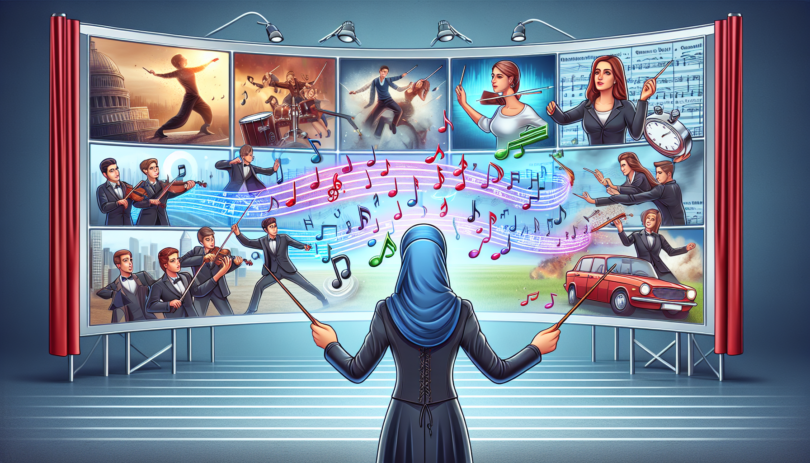Understanding Music Synchronization: Definition and Importance
What is Music Synchronization?
Music synchronization, often referred to as sync, is the process of aligning a piece of music with visual media, such as film, television, advertisements, or video games. This alignment ensures that the emotional, rhythmic, and dramatic elements of the music enhance the overall impact of the visual content. In essence, music synchronization is the art of marrying sound and visuals to create a cohesive and compelling experience for the audience.
The Role of Music Synchronization in Media Production
In media production, music synchronization plays a pivotal role. It helps set the tone of a scene, evoke specific emotions, and highlight important moments within the narrative. Whether it’s a suspenseful scene in a thriller or a heartwarming moment in a commercial, the right music can significantly amplify the audience’s emotional response. This makes music synchronization a crucial element in the storytelling process across various media formats.
Why Perfect Timing Matters in Music Synchronization
Perfect timing is the cornerstone of effective music synchronization. When music is precisely timed to coincide with specific visual cues, it creates a harmonious blend that enhances the viewer’s experience. Incorrect timing, on the other hand, can result in a disjointed and distracting experience, diminishing the intended impact of the media. Therefore, achieving perfect timing in music synchronization is essential for delivering a seamless and immersive audience experience.
Understanding Music Synchronization: Definition and Importance
What is Music Synchronization?
Music synchronization, commonly referred to as syncing, is the process of integrating music with visual media, such as films, advertisements, video games, and television shows. At its core, it ensures that the chosen musical tracks align perfectly with the visual content to enhance the audience’s overall experience. In the context of audiovisual production, music synchronization might involve timing specific moments within a song to match key scenes, actions, or dialogues in the visual narrative.
The Role of Music Synchronization in Media Production
Music synchronization plays a pivotal role in media production. It is not merely about adding background music; it involves the strategic placement and timing of musical elements to amplify the emotional impact of the visuals. For instance, a well-timed crescendo can elevate the tension in a thrilling scene or a perfectly timed melody can evoke a sense of nostalgia in a touching flashback. The intricate dance between audio and visual elements can transform a mundane scene into a memorable moment, thus enhancing the storytelling process. Whether in advertising, film-making, or game design, perfect synchronization ensures that the music complements and enriches the visual narrative, rather than distracting from it.
Why Perfect Timing Matters in Music Synchronization
The importance of perfect timing in music synchronization cannot be overstated. It involves precision and a deep understanding of both the musical and visual components. Here are some reasons why timing is crucial:
- Emotional Engagement: Music has the power to evoke strong emotions. By aligning music precisely with on-screen action, creators can evoke specific feelings, thereby deeply engaging the audience. For example, a sudden drop in music volume can coincide with a dramatic revelation, heightening the viewer’s emotional response.
- Storytelling: Music can serve as a narrative tool that guides the audience through the story. Perfect timing ensures that musical cues match specific plot points, helping to clarify and reinforce the storyline. This is particularly important in scenes where the dialogue is minimal, and the music carries the emotional and narrative weight.
- Rhythm and Flow: Synchronizing music with visuals helps maintain a natural rhythm and flow in the media. This leads to a more cohesive and fluid viewing experience. When the music and visuals are in harmony, the transition between scenes feels organic and effortless, keeping the audience immersed in the content.
- Memorability: Iconic scenes from movies, TV shows, or advertisements often owe their memorability to perfect music synchronization. Think of any classic film montage or an unforgettable commercial jingle; the magic lies in the precise timing of the music with the imagery, creating moments that stay with the audience long after the media has ended.
Perfect timing in music synchronization is both an art and a science. It requires creativity to choose the right tracks and technical skills to align these tracks with the visuals precisely. When done correctly, the result is a powerful and harmonious blend of sight and sound that captivates, informs, and entertains.
In summary, music synchronization is an indispensable aspect of modern media production. Its importance lies in its ability to enhance emotional engagement, aid in storytelling, provide a natural rhythm and flow, and create memorable moments. Achieving perfect timing in synchronization requires a combination of creative intuition and technical prowess, but the resulting impact on the audience is well worth the effort.
The Art of Music Synchronization: Creative Techniques and Best Practices
How to Choose the Right Music for Your Media Project
Choosing the right music for your media project is a cornerstone of effective music synchronization. The selection process demands a deep understanding of your project’s theme, mood, and target audience. Whether you’re working on a film, advertisement, or video game, the music you choose should complement the visual content and amplify the desired emotional response.
Start by identifying the emotional tone of your project. Is it uplifting, melancholic, or suspenseful? Each emotion can be enhanced by specific musical elements such as tempo, melody, and instrumentation. Once the desired feeling is identified, you can narrow down your options to music that fits this emotional landscape.
Consider the cultural context of your media project as well. Music that’s culturally relevant can deepen the connection with the audience. For example, using traditional Japanese instruments in a film set in Japan can make the story more authentic and immersive. Finally, always check the licensing agreements to ensure that you have legal rights to use the music in your project. Royalty-free music libraries and custom compositions are great resources for finding tracks that fit both your artistic vision and budget.
Techniques for Seamlessly Integrating Music with Visual Content
Once the right music is chosen, the next challenge in music synchronization is integrating it seamlessly with visual content. This involves precise timing, careful editing, and an intuitive understanding of how music and visuals interact.
One effective technique is to align musical beats with visual cuts. This can be done by marking beat points in the music and timing your cuts or transitions to these points. This alignment enhances the pacing of your media and creates a more engaging viewer experience. For example, in action sequences, syncing high-energy music with fast cuts can heighten the intensity, whereas, for a heartfelt scene, slower music may align with longer, more contemplative shots.
Dynamic volume control is another critical technique. Adjusting the volume of the music at key moments can emphasize certain visual elements or dialogue. Gradual fades, sudden stops, and crescendos should be used thoughtfully to create a more impactful narrative. Layering music tracks with natural sound effects or dialogue can also add depth and realism to your project.
Editing software provides various tools to facilitate the synchronization process. Programs like Adobe Premiere Pro, Final Cut Pro, and Avid Media Composer have built-in features allowing precise manipulation of both audio and visual elements. Learning how to effectively use these tools can significantly improve the quality of your music synchronization efforts.
Case Studies: Successful Music Synchronization in Famous Media Projects
Examining successful examples of music synchronization can provide valuable insights into the best practices and creative possibilities. Here are a few notable case studies:
1. **Baby Driver – Directed by Edgar Wright**
Baby Driver is a masterclass in music synchronization where every action scene is meticulously timed to the film’s soundtrack. Edgar Wright used music not just as background score but as an integral part of the narrative. The film demonstrates perfect timing, where car chases and shootouts sync flawlessly with the beats of songs, creating an exhilarating viewing experience.
2. **Guardians of the Galaxy – Directed by James Gunn**
Another exemplary project is Guardians of the Galaxy, where the soundtrack, composed of classic rock and pop songs, plays a significant role in defining the film’s tone. Each track is carefully chosen to reflect the emotions and actions of the characters, thereby enhancing the storytelling. The synchronized use of Hooked on a Feeling by Blue Swede, for instance, adds a nostalgic and playful vibe that resonates with the audience.
3. **Stranger Things – Created by The Duffer Brothers**
The popular TV series Stranger Things utilizes music synchronization to evoke the 1980s nostalgia effortlessly. The blend of an original synth-heavy score with era-appropriate pop songs enriches the narrative and deepens the immersion. Scenes such as Eleven’s telekinetic moments are often backed by hauntingly synchronized tunes that heighten the suspense and emotional stakes.
4. **Mad Men – Created by Matthew Weiner**
Mad Men is an exemplary show in using period-accurate music to enhance storytelling. The series often uses music from the 1960s to reflect the socio-cultural landscape of the era. The careful selection and synchronization of tracks like You Only Live Twice by Nancy Sinatra significantly enrich the viewing experience by adding context and depth to the narrative.
These case studies underline the importance of careful music selection and synchronization. By taking cues from these successful projects, creators can learn how to make their media more engaging and emotionally resonant.
The art of music synchronization lies in choosing the right music and integrating it flawlessly with visual elements. Through thoughtful selection, precise timing, and employing various techniques, creators can significantly enhance their media projects. By studying successful examples, one can draw inspiration and implement best practices to achieve perfect synchronization, ultimately elevating the overall impact of the media.
The Science Behind Music Synchronization: Tools and Technology
Digital Tools for Music Synchronization
In the burgeoning field of media production, digital tools have revolutionized the way we approach music synchronization. These tools assist creators in perfectly timing the music with visual elements, ensuring a seamless experience for the audience. Industry staples such as Pro Tools, Logic Pro X, and Adobe Audition provide robust functionalities that enable precise editing and synchronization of audio tracks with video frames.
Pro Tools, often regarded as the industry standard, offers advanced features such as Elastic Audio and Beat Detective, which allow for finely-tuned adjustments and perfect timing. Logic Pro X, another powerful digital audio workstation (DAW), provides users with comprehensive tools for editing and tempo mapping, making it easier to synchronize music with various types of media. Adobe Audition, primarily known for its integration with other Adobe Creative Cloud products, offers an intuitive interface for synchronizing audio to video, making it a preferred choice among multimedia creators.
The Role of AI and Machine Learning in Enhancing Timing Accuracy
Artificial Intelligence (AI) and Machine Learning (ML) have made significant inroads into the domain of music synchronization. These technologies are leveraged to enhance the timing accuracy and precision of synchronized music in ways previously unimaginable. AI algorithms can analyze beats, rhythms, and emotional tones of music tracks, ensuring they match the visual content perfectly.
For instance, platforms like AIVA (Artificial Intelligence Virtual Artist) utilize machine learning to compose and synchronize music specifically tailored to the visual dynamics of media content. Another example is Amper Music, which uses AI to create music tracks that can be seamlessly integrated into media projects, adjusting in real-time to match the changes in visual cues. These AI-driven tools substantially reduce the time and effort required to achieve perfect synchronization, all while maintaining high-quality standards.
Moreover, AI can predict synchronization flaws that might go unnoticed by human editors. By continuously learning from a vast array of data, these systems can adapt and improve their synchronization capabilities, minimizing human error and enhancing overall production quality.
Future Trends in Music Synchronization Technology
The future of music synchronization promises to be even more transformative with the advent of new technologies and innovative approaches. One trend gaining traction is the use of Virtual Reality (VR) and Augmented Reality (AR) in media projects, which demands an even higher level of precision in music synchronization. The immersive nature of VR and AR requires that music not only syncs with visual content but also adapts dynamically to user interactions.
Developers are working on immersive audio technologies like Dolby Atmos and DTS:X, which create three-dimensional soundscapes that enhance the storytelling experience. These technologies will necessitate advanced synchronization tools to ensure that music and sound effects are perfectly aligned with the immersive environments.
Another emerging trend is the integration of blockchain technology in the music industry, which could impact synchronization rights management. Blockchain can provide a transparent and efficient way to manage licenses for synchronized music, ensuring that creators are fairly compensated and that usage rights are clear and easily manageable.
Collaboration tools are also expected to evolve, allowing creators from different geographical locations to work together in real-time on synchronization projects. Cloud-based platforms and real-time editing tools will facilitate seamless collaboration, making it easier to achieve perfect timing regardless of physical distances.
In addition, advancements in quantum computing could potentially revolutionize music synchronization by providing computational power far beyond current capabilities. This could lead to more sophisticated AI algorithms capable of achieving unprecedented levels of precision in synchronization.
As these technologies continue to evolve, the convergence of creativity and science will open up new possibilities for innovative and emotionally compelling media experiences. The art of music synchronization is thus on a trajectory that promises not only enhanced technical precision but also enriched creative potential, paving the way for a future where media production reaches new heights of excellence.
Harmonizing Art and Science in Music Synchronization
The intricate dance between audio and visual elements in media, governed by the art and science of music synchronization, has revolutionized storytelling, advertising, and entertainment. As we’ve explored, the process requires a blend of creative intuition and technological prowess to achieve the perfect timing that elevates a project’s emotional impact and cohesion.
Music synchronization is not merely a technical task but an artistic endeavor. Selecting the right music involves understanding the emotional and narrative demands of the visual content and ensuring that each beat and note aligns seamlessly with on-screen action. The creativity involved in this process is backed by sophisticated digital tools and increasingly advanced technologies, such as AI and machine learning, which push the boundaries of what is possible.
Looking forward, the field of music synchronization is poised for exciting advancements. Emerging technologies will continue to enhance timing accuracy and provide new creative opportunities for media producers. Whether through cutting-edge software or innovative AI-driven algorithms, the future promises to bring even more precision and flexibility to music synchronization, enabling creators to tell more compelling and immersive stories.
In conclusion, perfect timing in music synchronization is an evolving synergy of artistic vision and scientific ingenuity. As practitioners continue to master and innovate within this domain, the transformative power of synchronized music will remain a cornerstone of powerful and evocative media production. The journey does not end here; it evolves, promising new horizons in the harmony of sound and vision.








